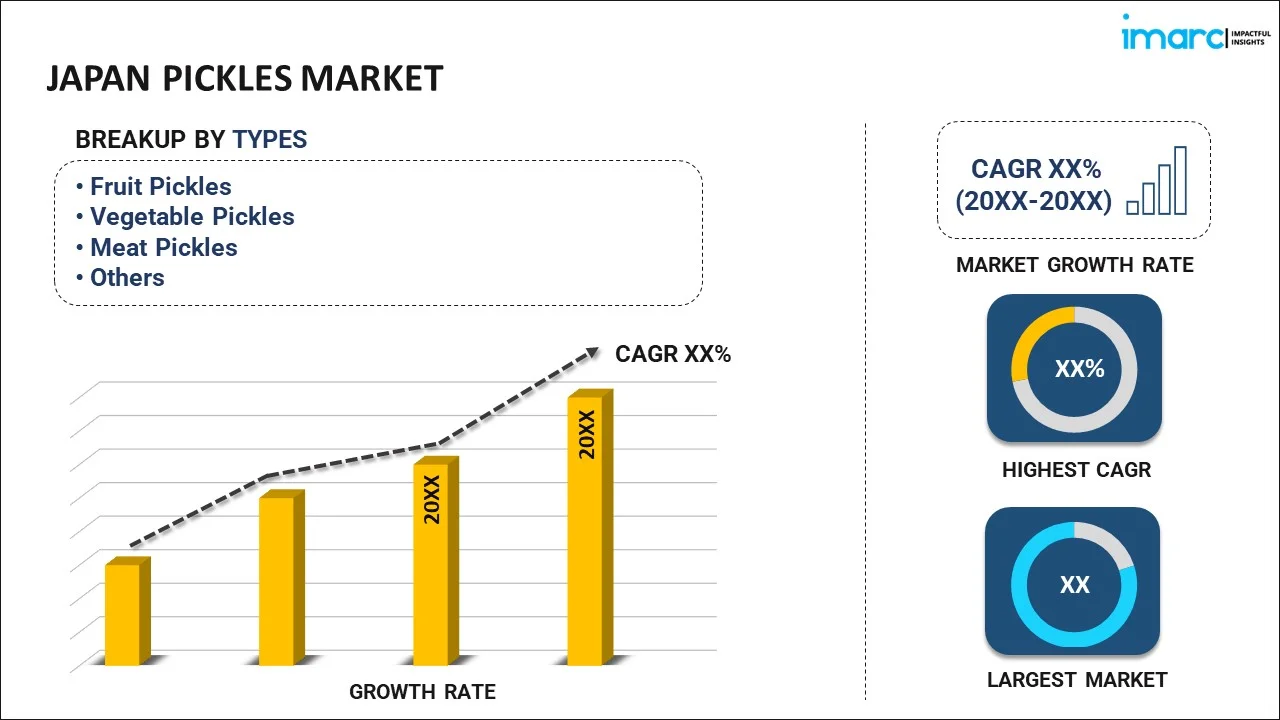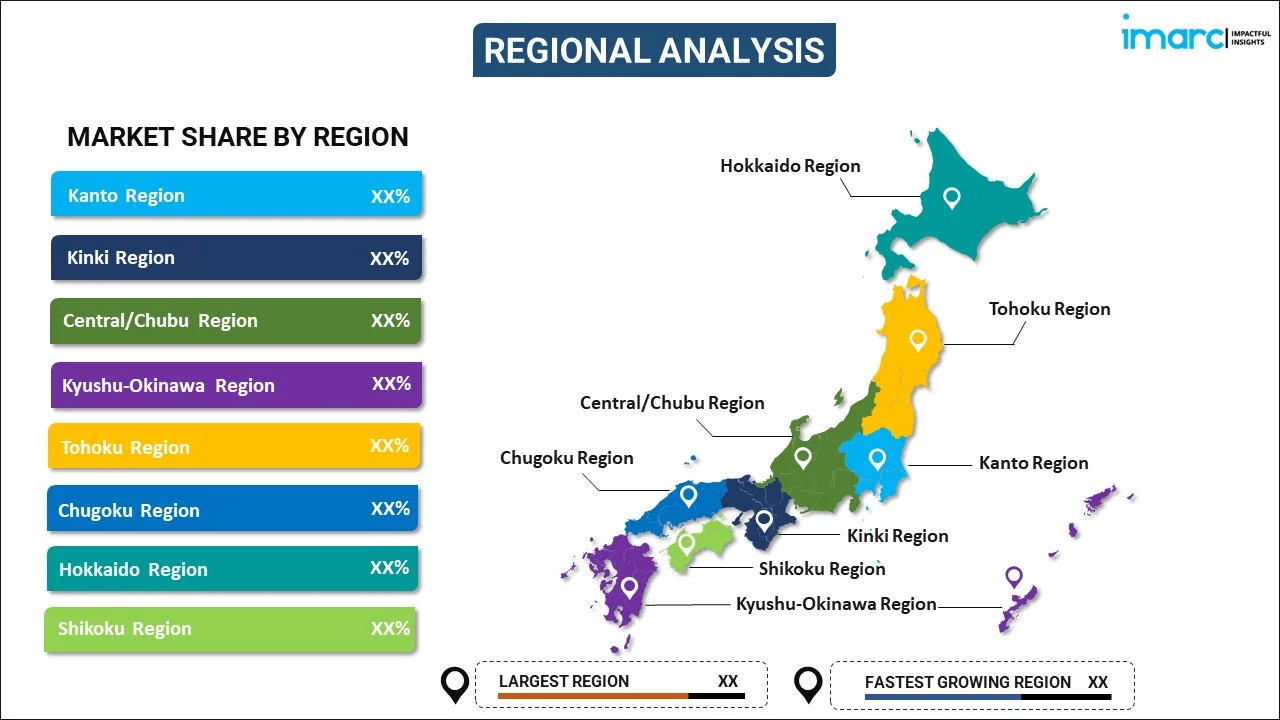
Japan Pickles Market Report by Type (Fruit Pickles, Vegetable Pickles, Meat Pickles, and Others), Taste (Sweet Pickles, Salty Pickles, Sour Pickles), Distribution Channel (Supermarkets and Hypermarkets, Convenience Stores, Independent Retailers, Online Stores, and Others), and Region 2025-2033
Market Overview:
The Japan pickles market size reached USD 393.8 Million in 2024. Looking forward, IMARC Group expects the market to reach USD 527.4 Million by 2033, exhibiting a growth rate (CAGR) of 3.1% during 2025-2033. The exposure to culinary tradition and heritage, rising health and wellness trends, flavor diversity, convenience and long shelf life, innovations in product packaging and distribution, the incorporation of pickled ingredients in fusion cuisine and international dishes represent some of the key factors driving the market.
|
Report Attribute
|
Key Statistics
|
|---|---|
|
Base Year
|
2024 |
|
Forecast Years
|
2025-2033
|
|
Historical Years
|
2019-2024
|
| Market Size in 2024 | USD 393.8 Million |
| Market Forecast in 2033 | USD 527.4 Million |
| Market Growth Rate (2025-2033) | 3.1% |
Pickles are a form of preserved food made from cucumbers that have been soaked in a solution of vinegar, water, and salt, along with various spices and flavorings. The process of pickling involves immersing the cucumbers in this brine solution, which enhances their flavor and extends their shelf life. As the cucumbers sit in the brine, they undergo a natural fermentation process facilitated by the presence of beneficial bacteria. This fermentation not only imparts a distinctive tangy flavor but also contributes to the preservation of the cucumbers. Pickles come in various types, including dill pickles, sweet pickles, and bread-and-butter pickles, each with its own unique blend of spices and flavorings. In addition to cucumbers, other vegetables and fruits can also be pickled, expanding the range of flavors and textures available. Pickled foods have gained popularity across cultures for their ability to add a zesty and savory element to meals, as well as for their potential health benefits due to the probiotics generated during the fermentation process. This traditional method of preservation continues to be celebrated for its ability to transform ordinary cucumbers into a flavorful and shelf-stable delicacy.
Japan Pickles Market Trends:
Pickled foods hold deep-rooted cultural significance in Japan. They are an integral part of traditional meals and are often served as accompaniments to rice dishes. This rich culinary heritage fosters a consistent demand for pickles, as they are considered essential elements of Japanese cuisine. Additionally, the growing emphasis on health-conscious eating habits has positively impacted the pickles market. Fermented and pickled foods are known for their probiotic content, which promotes gut health and overall well-being. This aligns with the contemporary consumer's desire for nutritious and functional foods. Other than this, Japan boasts a diverse range of pickle varieties, each distinguished by unique flavors and preparation methods. This diversity appeals to a broad spectrum of taste preferences, driving demand across different consumer segments. Besides this, pickled foods have the advantage of extended shelf life, making them convenient options for both household consumption and commercial use. This factor is particularly attractive in a fast-paced society like Japan, where consumers value products that can be stored and consumed over time. In line with this, the pickles market has witnessed innovations in packaging that enhance convenience and preserve freshness. Ready-to-eat packaging, single-serving portions, and resealable options cater to changing consumption patterns, such as on-the-go snacking and smaller households. Furthermore, the incorporation of pickled ingredients in fusion cuisine and international dishes has expanded the consumer base for pickled products. This trend encourages experimentation and paves the way for introducing pickles to new demographics. Moreover, the exposure to global culinary trends and the popularity of Japanese cuisine worldwide have sparked curiosity about authentic Japanese flavors, including pickles. This curiosity drives demand not only within Japan but also in international markets.
Japan Pickles Market Segmentation:
IMARC Group provides an analysis of the key trends in each segment of the Japan pickles market report, along with forecasts at the country level for 2025-2033. Our report has categorized the market based on type, taste, distribution channel.
Type Insights:

- Fruit Pickles
- Vegetable Pickles
- Meat Pickles
- Others
The report has provided a detailed breakup and analysis of the market based on the type. This includes fruit pickles, vegetable pickles, meat pickles, and others.
Taste Insights:
- Sweet Pickles
- Salty Pickles
- Sour Pickles
A detailed breakup and analysis of the market based on the taste has also been provided in the report. This includes sweet pickles, salty pickles, and sour pickles.
Distribution Channel Insights:
- Supermarkets and Hypermarkets
- Convenience Stores
- Independent Retailers
- Online Stores
- Others
The report has provided a detailed breakup and analysis of the market based on the distribution channel. This includes supermarkets and hypermarkets, convenience stores, independent retailers, online stores, and others.
Regional Insights:

- Kanto Region
- Kinki Region
- Central/Chubu Region
- Kyushu-Okinawa Region
- Tohoku Region
- Chugoku Region
- Hokkaido Region
- Shikoku Region
The report has also provided a comprehensive analysis of all the major regional markets, which include Kanto region, Kinki region, Central/Chubu region, Kyushu-Okinawa region, Tohoku region, Chugoku region, Hokkaido region, and Shikoku region.
Competitive Landscape:
The report has also provided a comprehensive analysis of the competitive landscape in the market. Competitive analysis such as market structure, key player positioning, top winning strategies, competitive dashboard, and company evaluation quadrant has been covered in the report. Also, detailed profiles of all major companies have been provided.
Japan Pickles Market Report Coverage:
| Report Features | Details |
|---|---|
| Base Year of the Analysis | 2024 |
| Historical Period | 2019-2024 |
| Forecast Period | 2025-2033 |
| Units | Million USD |
| Scope of the Report | Exploration of Historical and Forecast Trends, Industry Catalysts and Challenges, Segment-Wise Historical and Predictive Market Assessment:
|
| Types Covered | Fruit Pickles, Vegetable Pickles, Meat Pickles, Others |
| Tastes Covered | Sweet Pickles, Salty Pickles, Sour Pickles |
| Distribution Channels Covered | Supermarkets and Hypermarkets, Convenience Stores, Independent Retailers, Online Stores, Others |
| Regions Covered | Kanto Region, Kinki Region, Central/Chubu Region, Kyushu-Okinawa Region, Tohoku Region, Hokkaido Region, Shikoku Region |
| Customization Scope | 10% Free Customization |
| Post-Sale Analyst Support | 10-12 Weeks |
| Delivery Format | PDF and Excel through Email (We can also provide the editable version of the report in PPT/Word format on special request) |
Key Questions Answered in This Report:
- How has the Japan pickles market performed so far and how will it perform in the coming years?
- What has been the impact of COVID-19 on the Japan pickles market?
- What is the breakup of the Japan pickles market on the basis of type?
- What is the breakup of the Japan pickles market on the basis of taste?
- What is the breakup of the Japan pickles market on the basis of distribution channel?
- What are the various stages in the value chain of the Japan pickles market?
- What are the key driving factors and challenges in the Japan pickles market?
- What is the structure of the Japan pickles market and who are the key players?
- What is the degree of competition in the Japan pickles market?
Key Benefits for Stakeholders:
- IMARC’s report offers a comprehensive quantitative analysis of various market segments, historical and current market trends, market forecasts, and dynamics of the Japan pickles market from 2019-2033.
- The research study provides the latest information on the market drivers, challenges, and opportunities in the Japan pickles market.
- Porter's five forces analysis assist stakeholders in assessing the impact of new entrants, competitive rivalry, supplier power, buyer power, and the threat of substitution. It helps stakeholders to analyze the level of competition within the Japan pickles industry and its attractiveness.
- Competitive landscape allows stakeholders to understand their competitive environment and provides an insight into the current positions of key players in the market.
Need more help?
- Speak to our experienced analysts for insights on the current market scenarios.
- Include additional segments and countries to customize the report as per your requirement.
- Gain an unparalleled competitive advantage in your domain by understanding how to utilize the report and positively impacting your operations and revenue.
- For further assistance, please connect with our analysts.
 Inquire Before Buying
Inquire Before Buying
 Speak to an Analyst
Speak to an Analyst
 Request Brochure
Request Brochure
 Request Customization
Request Customization




.webp)




.webp)












